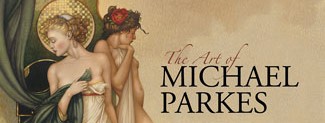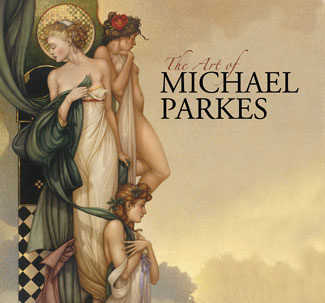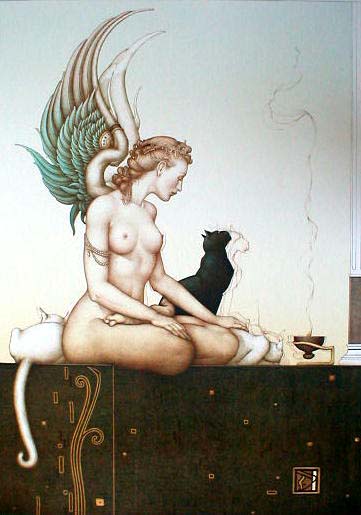



That Daring Young Frog
Original stone lithograph in 9 colors,
1986
Signed by the artist and numbered 77/250
Paper and image size: 22 3/4 x 30 3/4"
Available through this site half off
the sold-out value of $7,000 framed
$3,500 with archival-quality framing
Venus
|
A
Word from Michael Parkes about “Venus”
Venus is the Roman name for the
Greek goddess, Aphrodite. Generally, Venus is the goddess
of love and sensuality. Venus represents the descent of
divine feminine energy into the physical world.
The waters of the sea can be seen as the tumultuous
emotional body of humanity. She is the balance for
the present distortion of aggression on earth. Her
presence is of calm, knowing, patience, and love.
Her tools are not the swords of the battle field but of
beauty and harmony.I have used the flying figure before in my paintings. He represents the announcement of a major cosmic event. Here he is announcing a divine being, or consciousness, descending into a physical form to help the earth. The mask that Venus is holding is the mask of sorrow, confusion, and misery. Behind the mask, there is the promise of what this feminine energy brings. Take the symbolism for what it is. It is not important to understand or even agree with the symbols I use. What I do want is to offer my art to people to enjoy and enhance their lives with the beauty of color and light. |
Click play button above for a
You Tube video of Michael Parkes talking about Venus -- now
at Saper Galleries
And if you liked that video, check out these:
Painting
Techniques at his Studio in Southern Spain, May, 2008
More
Painting Techniques
From
Ideas to Paintings Part I
From
Ideas to Paintings Part II

|
Michael Parkes The Artist
Michael Parkes is America's leading Magic Realist painter and printmaker. Though he studied graphic art and painting at the University of Kansas, his unique style evolved very much in isolation, after a period in which he gave up the practice of art altogether and went off to India in search of philosophical illumination: born in 1944, he was very much of the hippie generation. Earlier on, he had painted in the generally Abstract Expressionist style normal among his teachers, but after his pause for reflection he began to draw and paint in a meticulous style of detailed representation which would enable him to give full expression to his inner world of images. The style was in principle realistic, the subject matter magical, and Magic Realism has characterised his work ever since. He has studied deeply in esoteric doctrine of the East and the West, and his imagery is drawn from a range of wisdoms including the Cabalistic and the Tantric, but embodied in forms from his own imagination which are immediately accessible. Here strange beasts encounter mysterious winged women, good and evil fight out their immemorial conflict (though who can be perfectly sure which is which?), and in this weightless environment worlds are unmade and remade nearer to the heart's desire. Even as a student Parkes was
fascinated by various graphic processes, and in
recent years he has become highly proficient in the
difficult medium of the colour stone lithograph.
|

|
The Lithographs
Michael Parkes began making stone lithographs in the early eighties and regarded it as an extension of his drawing techniques. Since then he has been making three to four new lithograph editions a year and now the complete collection of his lithographs comprises more than seventy different images. The artist designs and prints his lithographs in Switzerland. Although many artists have turned to the easier zinc or aluminium plates, Michael Parkes prefers the use of stones. He considers the 160 million years old Solnhofen stones he uses for his lithographs to be an integral part of the creative process. The process starts with drawing the image on the stone by using a greasy lithographic pencil. This usually takes three to 12 days, depending on the size and complexity of the image. The main challenge is that mistakes cannot be erased. Small corrections can be made with a sharp knife, but if major corrections are needed, it is necessary to start again on a new stone. After the basic design is drawn on the stone, the printer becomes involved. The tradition of master printer is handed down from one generation to the next. The printers Parkes works with were taught by the master that printed Kokoschka, Giacometti and Leger. Questions of composition, colour and atmosphere are discussed between printer and artists before printing begins. The initial drawing only gives a suggestion of what the actual lithograph will become. The unpredictability of the process means that the original ideas might have to be changed several times to correct mistakes or to take advantage of 'accidents' that look promising. Now the drawing is on the stone, it needs to be etched onto the surface of the stone to be used for printing. What makes the lithographic process possible is the principle that oil and water do not mix. The etch makes the image more receptive to the ink while the stone remains perfectly flat. But if the stone is not properly prepared and etched the image is either etched away or starts to fill in with the ink after only a short time. After etching, the colour is mixed to begin printing. During the printing, which is done on a Heidelberg press built in 1906, the stone must be kept wet at all times. The ink is controlled in small quantities during printing to maintain a balanced edition. Even though there are numerous techniques for printing a stone lithograph, the traditional approach is to use one litho stone for each colour. When printed, the colours and designs are superimposed to complete the finished image. This technique was created primarily for security the last century when large editions were printed. Michael Parkes uses quite a different process for printing his work. His technique is described by some artists as the "suicide run", because it relies on only one stone to produce the total image. When the basic design is drawn and each new element is added to the stone, a portion of the original drawing is destroyed. Add to this the fact that when printing on wet paper your time is limited, it becomes clear that this technique is not for everyone. Parkes' lithographs can use as many as twelve different colours, and so twelve different printings. Once the edition is printed, it is dried over four or five days. Parkes signs and numbers each lithograph. Then, the image on the stone is ground away to prepare it for the next artist. This guarantees the limited number of the edition. Some of the stones have been used for over 100 years and still have enough surface for many years to come. The historical tradition of lithography seems especially clear to Parkes as he works on a stone that has witnessed the passing of time through the work of artists like Whistler, Toulouse Lautrec, Giacometti, Picasso or Wunderlich. For Michael Parkes the project's end means the journey is beginning once again. It is our pleasure to offer you from our inventory on display at Saper Galleries, this and other works by Michael Parkes! |
Saper
Galleries....where excellence is the standard!




433 Albert Avenue East Lansing, Michigan 48823 USA (517)351-0815